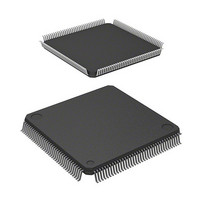R5F61665N50FPV Renesas Electronics America, R5F61665N50FPV Datasheet - Page 443

R5F61665N50FPV
Manufacturer Part Number
R5F61665N50FPV
Description
MCU FLASH 512K ROM 144-LQFP
Manufacturer
Renesas Electronics America
Series
H8® H8SX/1600r
Datasheet
1.R5F61665N50FPV.pdf
(1492 pages)
Specifications of R5F61665N50FPV
Core Processor
H8SX
Core Size
16/32-Bit
Speed
50MHz
Connectivity
EBI/EMI, I²C, IrDA, SCI, SmartCard, USB
Peripherals
DMA, LVD, POR, PWM, WDT
Number Of I /o
92
Program Memory Size
512KB (512K x 8)
Program Memory Type
FLASH
Ram Size
40K x 8
Voltage - Supply (vcc/vdd)
3 V ~ 3.6 V
Data Converters
A/D 8x10b; D/A 2x8b
Oscillator Type
External
Operating Temperature
-20°C ~ 75°C
Package / Case
144-LQFP
Lead Free Status / RoHS Status
Lead free / RoHS Compliant
Eeprom Size
-
Available stocks
Company
Part Number
Manufacturer
Quantity
Price
Company:
Part Number:
R5F61665N50FPV
Manufacturer:
Renesas Electronics America
Quantity:
10 000
- Current page: 443 of 1492
- Download datasheet (8Mb)
(3)
A transfer is started by a transfer request signal (DREQ) from an external device. When a DMA
transfer is enabled (DTE = 1), the DMA transfer is started by the DREQ assertion. When a DMA
transfer between on-chip peripheral modules is performed, select an activation source from the
auto request and on-chip module interrupt (the external request cannot be used).
A transfer request signal is input to the DREQ pin. The DREQ signal is detected on the falling
edge or low level. Whether the falling edge or low level detection is used is selected by the
DREQS bit in DMDR.
When an external request is selected as an activation source, clear the DDR bit to 0 and set the
ICR bit to 1 for the corresponding pin. For details, see section 13, I/O Ports.
10.5.4
There are two types of bus access modes: cycle stealing and burst.
When an activation source is the auto request, the cycle stealing or burst mode is selected by bit
DTF0 in DMDR. When an activation source is the on-chip module interrupt or external request,
the cycle stealing mode is selected.
(1)
In cycle stealing mode, the DMAC releases the bus every time one unit of transfers (byte, word,
longword, or 1-block size) is completed. After that, when a transfer is requested, the DMAC
obtains the bus to transfer 1-unit data and then releases the bus on completion of the transfer. This
operation is continued until the transfer end condition is satisfied.
When a transfer is requested to another channel during a DMA transfer, the DMAC releases the
bus and then transfers data for the requested channel. For details on operations when a transfer is
requested to multiple channels, see section 10.5.8, Priority of Channels.
Activation by External Request
Cycle Stealing Mode
Bus Access Modes
Rev. 2.00 Oct. 21, 2009 Page 409 of 1454
Section 10 DMA Controller (DMAC)
REJ09B0498-0200
Related parts for R5F61665N50FPV
Image
Part Number
Description
Manufacturer
Datasheet
Request
R

Part Number:
Description:
KIT STARTER FOR M16C/29
Manufacturer:
Renesas Electronics America
Datasheet:

Part Number:
Description:
KIT STARTER FOR R8C/2D
Manufacturer:
Renesas Electronics America
Datasheet:

Part Number:
Description:
R0K33062P STARTER KIT
Manufacturer:
Renesas Electronics America
Datasheet:

Part Number:
Description:
KIT STARTER FOR R8C/23 E8A
Manufacturer:
Renesas Electronics America
Datasheet:

Part Number:
Description:
KIT STARTER FOR R8C/25
Manufacturer:
Renesas Electronics America
Datasheet:

Part Number:
Description:
KIT STARTER H8S2456 SHARPE DSPLY
Manufacturer:
Renesas Electronics America
Datasheet:

Part Number:
Description:
KIT STARTER FOR R8C38C
Manufacturer:
Renesas Electronics America
Datasheet:

Part Number:
Description:
KIT STARTER FOR R8C35C
Manufacturer:
Renesas Electronics America
Datasheet:

Part Number:
Description:
KIT STARTER FOR R8CL3AC+LCD APPS
Manufacturer:
Renesas Electronics America
Datasheet:

Part Number:
Description:
KIT STARTER FOR RX610
Manufacturer:
Renesas Electronics America
Datasheet:

Part Number:
Description:
KIT STARTER FOR R32C/118
Manufacturer:
Renesas Electronics America
Datasheet:

Part Number:
Description:
KIT DEV RSK-R8C/26-29
Manufacturer:
Renesas Electronics America
Datasheet:

Part Number:
Description:
KIT STARTER FOR SH7124
Manufacturer:
Renesas Electronics America
Datasheet:

Part Number:
Description:
KIT STARTER FOR H8SX/1622
Manufacturer:
Renesas Electronics America
Datasheet:

Part Number:
Description:
KIT DEV FOR SH7203
Manufacturer:
Renesas Electronics America
Datasheet:











